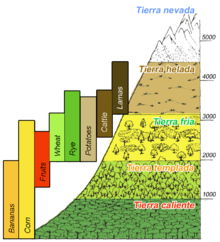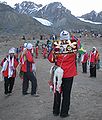Life zones of Peru
In today's world, Life zones of Peru is a topic that has acquired unprecedented relevance. Since its inception, it has aroused great interest and has been the subject of multiple studies and research in various fields. With the passage of time, Life zones of Peru has evolved and adapted to changes in society, becoming a current topic that continues to generate debate and controversy. In this article, we will explore the different aspects of Life zones of Peru, analyzing its impact today and reflecting on its importance in the contemporary world.
When the Spanish arrived, they divided Peru into three main regions: the coastal region (11.6% of Peru), that is bounded by the Pacific Ocean; the highlands (28.1% of Peru), that is located on the Andean Heights, and the jungle, that is located on the Amazonian Jungle (Climate of Peru). But Javier Pulgar Vidal (es), a geographer who studied the biogeographic reality of the Peruvian territory for a long time, proposed the creation of eight Natural Regions. In 1941, he presented his thesis "Las Ocho Regiones Naturales del Perú" at the III General Assembly of the Pan-American Institute of Geography and History.

These eight Peruvian regions are:
- Chala or Coast (subtropical dry and tropical savanna)
- Yungas
- Fluvial Yunga
- Loma-Vegetation
- Quechua
- Suni or Jalca
- Puna
- Janca
- Rupa - Rupa or Highland Jungle
- Omagua or Lowland Jungle
Example: Andes 10°S
- See also Altitudinal zonation
Classic version, Amazonic side

- Sea level
- Estimated 22 - 24°C (75°F), but the cold Humboldt Current generates fog on the coast side
- Tierra caliente (Hot land, tropical) up to 2,500 ft (about 750 m - 1,000 m).
- Tierra templada (Temperate land, subtropical) up to 6,000 ft (about 1,850 m – 2,000 m)
- The warmest month has an average temperature of below 22°C or 72°F.
- Crops: Coffee, Tobacco, Maize, Coca, Peruvian Pepper (Schinus molle), Avocado, Guave (Psidium guajava), Cherimoya, Plum, Citrus fruits.
- Tierra fría (Cool land, temperate) below 12,000 ft (about 3,600 m, treeline)
- Tierra helada (Cold land) above 12,000 ft (about 3,600 m)
- Tierra Nevada (Janca), above the snow line, 15,000 ft (about 4,500 m - 5,000 m)
Javier Pulgar Vidal's version
The Peruvian geographer Javier Pulgar Vidal divided Peru in 8 regions (traditionally, it was costa, sierra and selva):
Map from República del Perú - Instituto Geográfico Nacional
- Chala (West, Pacific Coast) 0– 500 m
- Omagua (Lowland jungle or Selva baja, Amazonic rainforest) 80– 400 m
- Rupa-Rupa (Highland jungle, Selva alta) 400– 1,000 m
- Yungas (Aymaran for "Warm Lands", Cloud forest)
- Loma-Vegetation (West, "Yunga coastal" at the north of Peru) 450– 600 m
- Fluvial Yungas (East, "Yunga fluvial") 1,000- 2,300 m
- Quechua (East, High valleys) 2,300– 3,500 m
- Suni (or Jalca or Sallqa too, high plateaus and cliffs) 3,500– 4,100 m
- Puna (means "mountain top") 4,100– 4,800 m
- Janca (means white) above 4,800 m, permafrost, rocks, snow and ice
Notes
- Biomes & Ecoregions nearby:
Tropical and subtropical moist broadleaf forests
Montane grasslands and shrublands
Overview - Amazonic side
- Mouth of the Amazon River, Atlantic Ocean
- Belém, Brazil, 24 m, annual mean temperature 26.0°C
- Gurupa várzea (NT0126)
- Manaus, Brazil, 72 m, annual mean temperature 26.6°C
- Monte Alegre várzea (NT0141)
- Purus várzea (NT0156)
- Colombia - Peru - Brazil border
- Leticia, Colombia, 84 m, annual mean temperature 25.8°C
- Tierra Caliente or Tropical rainforest
- Omagua or Selva baja (Southwest Amazon moist forests - NT0166)
- Iquitos, Peru, 126 m, annual mean temperature 26.2°C
- Rupa-Rupa or Selva alta (Iquitos várzea - NT0128)
- Yunga fluvial (more than 5°C colder than the Peruan Tropics)
- Peruvian Yungas (NT0153)
- Quechua (High valleys, more than 10°C colder than the Peruan Tropics)
- Tree line
- Tierra Helada
- Suni (plateau)
- Tierra Helada
- Mountain pass
- Puna (mountain slope)
- Central Andean wet puna (NT1003)
- Central Andean puna (NT1002)
- "Andean-Alpine desert"
- Puna (mountain slope)
- Snow line
- Tierra Nevada or Janca
- Peak
Estimated temperatures - Continental Divide
Explanations:
- Region, elevation (m); avg annual precipitation (mm); avg annual temperature (°C);
- Peruvian Highland Rainforest (Tropical climate), Cloud forest (Subtropical climate) and Temperate forest (Temperate climate);
- Cusco reference, estimated avg annual temperature (°C, Lowland Rainforest or Selva baja gets more rain, so it is more cloudy, so it is cooler);
- Snow line reference, Humboldt cold current/ Pacific climate influence, estimated avg annual temperature (°C).
| Elevation | West - Pacific side | East - Amazonian side | |
|---|---|---|---|
| Highland Rainforest or Selva alta | 400 m | - | 26.5 °C |
| Loma-Vegetation | 500 m | about 21.1 °C | - |
| Cloud forest or Fluvial Yunga | 1,000 m | - | 23.5 °C |
| Quechua - Montane Valleys | 2,300 m | - | 17.2 °C |
| Amazonian Tree line of Coniferae: 10 °C | about 3,500 m | - | about 10 °C |
| Mountain pass influence | 4,100 m | about 3.4 °C | (about 7.1 °C) |
| Vegetation end | about 4,800 m | about 0.0 °C | - |
| Snow line | about 5,000 m | about -1.0 °C | - |
Example: Kallawaya Region, Bolivia
Altitudinal zonation: Kallawaya Region, around Charazani, Bolivia (border to Peru).
- Glacier
- Elevation: 5,900- 5,200 m, Annual mean temperature: below 0 °C, Agriculture: none
- High Mountain Desert, Werneria ciliolata on scree
- Elevation: 5,200- 5,000 m, Annual mean temperature: below 0 °C - 0 °C, Agriculture: none.
- Grass Zone
- Calamagrostis minima Steppe,
- Elevation: 5,000- 4,600 m, Annual mean temperature: 0- 3.5 °C, Farming: alpacas, lamas.
- Pycnophyllum Steppe,
- Elevation: 4,600- 4,300 m, Annual mean temperature: 3.5- 7.5 °C, Farming: alpacas, lamas.
- Aciachne Humid Grassland,
- Calamagrostis minima Steppe,
- Shrub Zone
- Satureja Shrub (westslope), Baccharis pentandii Shrub, with Berberis (eastslope),
- Mutisia Shrub (westslope), Baccharis pentlandii Shrub, with Siphocampylus (eastslope),
- Kaunia longipetiolata Shrub,
- Elevation: 3,200- 2,700 m, Annual mean temperature: 13.5- 16.5 °C, Farming: cattle; Agriculture: maize, wheat, beans, spring potatoes, use of fertilizers, no crop rotation.
- Highland Rainforest,
Gallery
-
Costa - Sierra - Selva
-
Rupa-Rupa - High Rain forest
-
Mist forest (2,500 m)
-
Mountain slope (4,000 m)
-
Lake Quñuqqucha (4,050 m)
-
Puna with shrubs
-
Region of Ayacucho, Peru, 1986 - Puna
-
Region of Ayacucho, Peru, 1986 - Puna
-
Quyllur Rit'i, glacier and alpine desert - 2007
See also
References
- ^ a b Pulgar Vidal, Javier: Geografía del Perú; Las Ocho Regiones Naturales del Perú. Edit. Universo S.A., Lima 1979. First Edition (his dissertation of 1940): Las ocho regiones naturales del Perú, Boletín del Museo de Historia Natural „Javier Prado“, n° especial, Lima, 1941, 17, pp. 145-161.
- ^ Benavides Estrada, Juan (1999); Geografía del Perú 2do año de Secuandaria. Lima: Escuela Nueva.
- ^ Brigitta Schütt (2005); Azonale Böden und Hochgebirgsböden
- ^ Zech, W. and Hintermaier-Erhard, G. (2002); Böden der Welt – Ein Bildatlas, Heidelberg, p. 98.
- ^ Christopher Salter, Joseph Hobbs, Jesse Wheeler and J. Trenton Kostbade (2005); Essentials of World Regional Geography 2nd Edition. NY: Harcourt Brace. p.464-465.
- ^ Middle America: Altitudinal Zonation Archived 2009-07-24 at the Wayback Machine
- ^ "Cordillera Blanca, Peru (Huaraz, Caraz)". Archived from the original on 2012-03-12. Retrieved 2013-10-25. Maps of the Cordillera Blanca - Peru
- ^ WWF Global 200: World Map of 14 Terrestrial Biomes and 867 Ecoregions
- ^ "Bolivian Yungas". Terrestrial Ecoregions. World Wildlife Fund.
- ^ a b "Peruvian Yungas". Terrestrial Ecoregions. World Wildlife Fund.
- ^ a b "Southwest Amazon moist forests". Terrestrial Ecoregions. World Wildlife Fund.
- ^ "Central Andean dry puna". Terrestrial Ecoregions. World Wildlife Fund.
- ^ a b "Central Andean puna". Terrestrial Ecoregions. World Wildlife Fund.
- ^ "Central Andean wet puna". Terrestrial Ecoregions. World Wildlife Fund.
- ^ "Atacama desert". Terrestrial Ecoregions. World Wildlife Fund.
- ^ "Sechura desert". Terrestrial Ecoregions. World Wildlife Fund.
- ^ "Gurupa varzea". Terrestrial Ecoregions. World Wildlife Fund.
- ^ "Monte Alegre varzea". Terrestrial Ecoregions. World Wildlife Fund.
- ^ "Purus varzea". Terrestrial Ecoregions. World Wildlife Fund.
- ^ "Iquitos varzea". Terrestrial Ecoregions. World Wildlife Fund.
- ^ "Central Andean wet puna". Terrestrial Ecoregions. World Wildlife Fund.
- ^ Klimadiagramme weltweit - Europa
- ^ Seibert, Paul; Farbatlas Südamerika, Verlag Eugen Ulmer, 1996.















